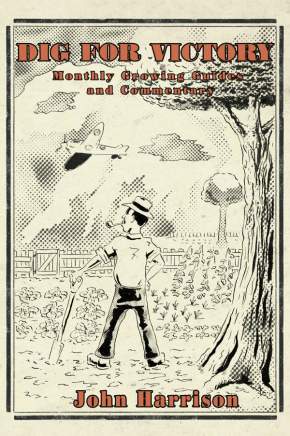
TOMATO GROWING IS NOT DIFFICULT
How Amateurs Can Produce this Valuable Health-Giving Fruit
DIG FOR VICTORY LEAFLET No. 8 (Page 4 of 4)
STORAGE
Fruits which, although mature, have not ripened by the time of the onset of autumn frosts may be stored separately in such receptacles as trays or box-lids lined with a few layers of newspaper which will help to ensure that the fruits remain where placed.
The fruits should be in a single layer and arranged so that they do not touch one another. If there is any risk of this occurring, separate the rows of fruit by strips of newspaper. Do not store any split bruised, or otherwise damaged fruits.
The trays should be placed in a room, cupboard, or drawer where the temperature is about 55° F. (not under 50° F. and preferably not over 60° F.). A room where the temperature is liable to fall below 50° F. at night should, if possible, be avoided. A temperature above 60° F. may cause shrivelling but is otherwise less harmful.
Store the fruit in the dark, but if it is desired to hasten the ripening of some of the fruit these should be exposed to the light, at a temperature of 60-65° F. Storage in the dark tends to prolong the period of storing. Thus the period during which tomatoes are available may be extended appreciably.
The fruits should be examined from time to time to remove any that have ripened or any that begin to show signs of decay.
Storing the fruits in peat or sawdust is not recommended, as the latter sometimes imparts an unpleasant flavour and both are difficult to maintain at the right degree of dryness.
It should be remembered that though very dry conditions may induce shrivelling of the fruit, appreciable moisture favours the growth of moulds which will develop quickly under the slight warmth otherwise conducive to the keeping of tomatoes. For this reason, storage in the moist warmth of a kitchen is inadvisable. Green immature fruits may be used for chutney and pickle.
DISEASES AND PESTS
Blight is the chief source of trouble to outdoor tomatoes, and in cases of severe attack it will kill the plants completely. It is most likely to occur under damp, close weather conditions. This is the same blight that attacks potatoes, and to guard against attacks, plants should be sprayed at intervals with Bordeaux or Burgundy mixture or with one of the proprietary brands of copper preparations now on the market. (See “Dig for Victory” Leaflet No. 9).
White Fly can be a serious pest in greenhouses. Always make certain that purchased plants are free from this pest ; for it is difficult to control if once established.
This insect is described, and particulars of measures of control are given in Advisory Leaflet No. 86.
Leaf Mould is a serious malady of fungoid origin affecting the foliage of plants under glass. Well managed plants in properly ventilated houses are less prone to attack. Close, damp atmospheres and soft foliage encourage the disease. Full details of the disease are given in Advisory Leaflet No. 263.
Free copies of the leaflet mentioned may be obtained on application to the Ministry at the address below.
Issued by the Ministry of Agriculture and Fisheries, Hotel Lindum —St. Annes – on – Sea—Lancashire.
December 1943


